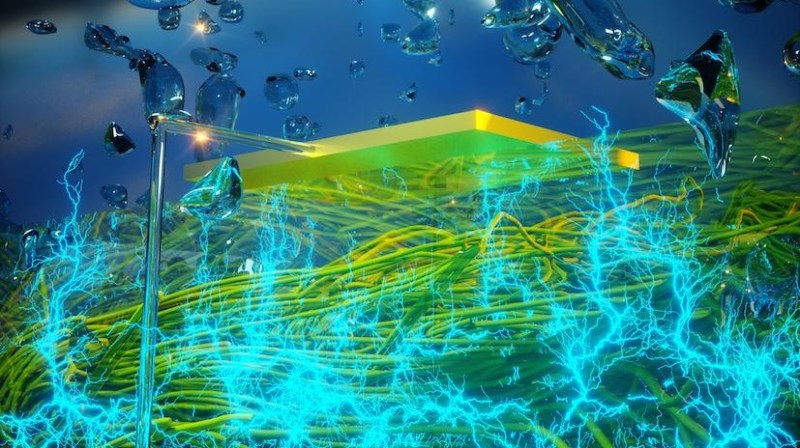Generating electricity out of thin air is the fantasy for our modern technology dependant world, but still falls squarely in the world of science fiction. However, researchers from the University of Massachusetts Amherst claim that they have found a way to do exactly that, using protein nano-wires to produce tiny amounts of electricity from ambient humidity.
The protein nano-wires in question are harvested from the microbe Geobacter sulfurreducens, to create a 7 µm thick film that is placed between two gold electrodes. One electrode completely covers the back of the film, while the front electrode covers only a tiny portion of the surface area. When the film is exposed ambient moisture, researchers measured 0.4 V – 0.6 V produced continuously for more than two months. The current density was about 17 µA/cm². This is only a fraction of the output of a commercial solar panel, but it can be layered with air gaps in between. The electricity is supposedly produced due to a moisture gradient through the thickness of the film. Harvesting energy using ambient humidity is not new, but the improvement in power density on this study is at least two orders of magnitude larger than that of previous studies.
The researches have named the technology Air-Gen and hope to develop it commercially. As we have seen many times before, promising lab results often don’t translate well into real world products, but this technology is definitely interesting.
We’ll continue to see all sorts of weird and wonderful ways to free up electrons, like using sweat, but we’ll have to wait and see what sticks.
Thanks for the tip [William Polo]!
















I expect that mineral deposits that either insulate or short circuit the thing will make it unworkable in real world use.
Not sure if you’re expecting water vapor to carry limescale or whether you’re talking about fine loess or micrometeoritic dust.
…sounds easily remedied with good filtration. As long as the pores are large enough to let water through but nothing much bigger, things should go well…. N95 masks? ;-)
Or Tyvek type stuff I guess.
17mA /cm2 is A LOT. Unfortunately, the actual value from the paper is 17uA…
Oh, come one, don’t be so pedantic, he just got one letter wrong …;)
Yea, like the diference between “You’re Fired” and “You’re Hired” :-) or “Honey, will you go to the refrigerator and bring me a bear?” :-)
The power of one letter ;) Fixed, thanks
And here I wonder how this thing produces power long term.
How is the humidity gradient in the film sustained? If it now is the gradient that produces the power.
It is though an interesting topic.
I would imagine that it is highly hygroscopic at the surface.
Ah, thanks for looking that up. My hairs were already bristling up at 17mA…
You have to wonder the state of scientific publishing when even Nature lets through a spelling error in the very first paragraph. But I digress…
The authors make a convincing case that is isn’t something other than humidity gradient: they remove oxygen, remove nitrogen, check for protein decomposition, vary humidity, do long-term runs, etc. They really are presenting this with the expectation that it’s radical and will be challenged. They acknowledge they really don’t understand the mechanism but postulate some.
But it seriously doesn’t pass the sniff test. They claim (and show) that simply exposing the device to humid air produces power: NOT exposing it to a humidity gradient. They claim the gradient is produced inside the device. There is no way a gradient can be maintained indefinitely against a flux (of ions, electrons, reagents, whatever), without some consumable that will ultimately need to be replaced. Otherwise it’s a perpetual motion machine.
Sounds like Pons & Fleischman all over again.
I would expect that it will require fresh moving air all the time to maintain said gradient…ie fluctuating humidity levels. If held at one level for long enough it probably ceases functioning. I also imagine that long term there is some form of corrosion(I know…gold) going on. The current density is very tiny, although stackable.
No moving air. No ambient gradient. Read the paper.
Call me cynical but doesn’t this break all kinds of laws of thermodynamics if there is no gradient? ‘Ambient’?. If it’s creating its own gradient then that also needs energy input. If they are only measuring micro-amps, is there a chance there is some kind of stray field coming in from somewhere else. The ‘gods of the copybook headings’ probably have something to say about it. Lots of gimmicky and click-baitey stuff in Nature these days, its going down the pan.
As someone from Western Mass, I just want to take this opportunity to let everyone know that the “H” in “Amherst” is silent. Same thing goes for Amherst College.
There is an Amherst, NY that does pronounce it the other way, but whatever. ¯\_(ツ)_/¯
Thank you for reading this Very Important Message.
Is the “n” silent in “Fnuh”?
It’s a name, which is arbitrary. If they wanted it pronounced a certain way, they ought to spell it that way.
When this can create enough power to run my CNC mill call me.
Well, hey, they say they can generate a kilowatt per cubic meter of their magical film/air sandwich. A small closet full of the stuff should be able to run your mill.
Sure. What’s your phone number?
From a perspective of very basic thermodynamics, it seems that if the bacteria are producing the power, they’ll need to be FED to sustain their output. How can this be anything other than a novel bioreactor design, turning fuel into electricity?
RTFA: The protein nanowires are harvested from the microbe. There is no bioreactor in the game, so is claimed.
Gold? Now the meth heads have new target. Any captured ambient moisture, tends to dissipate fairly quickly. This product, is going to have very short time slot to produce a minuscule amount of power.